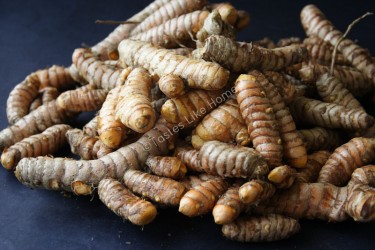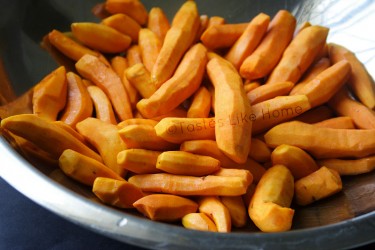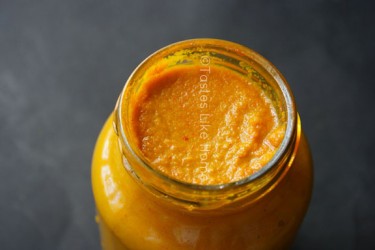Hi Everyone,
Have you ever seen what that golden powder, also known as turmeric and dye looks like in its fresh form?
Here’s what it looks like – slender and ginger-like but with orange hues emanating from the deep, profoundly rich colour of its flesh.


Just as how ginger in its fresh form is different in flavour to its dried form, so too is turmeric. Fresh turmeric has a fruity, citrus aroma and it is not as bitter as its dried version.
 Here in Barbados, fresh turmeric is readily available and its use is prolific in Bajan cuisine. If you’ve ever seen Bajan pepper sauce, you will notice that it has a signature colour – red to orange with hints of yellow or gold.
Here in Barbados, fresh turmeric is readily available and its use is prolific in Bajan cuisine. If you’ve ever seen Bajan pepper sauce, you will notice that it has a signature colour – red to orange with hints of yellow or gold.
That is due to the fresh turmeric in the pepper sauce which not only adds colour and flavour to the pepper sauce but it also acts as a preservative. Bajans put a little turmeric in many of their dishes – soups, stews, rice, and of course curries. Actually many of their dry seasoning mixes have in turmeric. Anything that needs a little colour enhancement, gets a treatment of ‘lil fresh turmeric.
Turmeric has long been used in Ayurveda (a system of traditional Indian medicine) to heal wounds, treat skin conditions, boost the immune system, and aid digestion.
Turmeric is highly prized as it is said to have powerful anti-inflammatory, anti-fungal and anti-bacterial properties. As you can see, turmeric is used both for its flavour, colour and medicinal properties.
When used in combination with annatto (achiote), fresh turmeric, works as a dye, a natural food colouring. Cheese, yogurt, butter, margarine, salad dressings, mustards etc are all foods that the annatto/turmeric combination can be used to colour. There is a cooking butter here in Barbados called Curry Kreem Spread® that is very popular with its signature gold-green curry colour that is influenced from the fresh turmeric.
Those of us who come from countries such as Guyana, Trinidad & Tobago, Suriname and other countries with large Indian populations, would, at some point in time, attended the celebrations of weddings where the bride and groom were “rubbed” with dye – a practice that still obtains today. The rubbing of the turmeric paste on the bodies of the bride and groom is to cleanse, soften and purify the skin, and to give it a glow; make the skin radiant for the special day.
If you ever get the opportunity to use fresh turmeric, I’d encourage you to try it. These days, because I have ready access to the fresh variety, I rarely use the dried version, but I always have it stocked because some spice mixes require the use of the dried rather than the fresh variety.
Fresh turmeric keeps well in the refrigerator, unpeeled, or peeled and grated (or blended to a paste). It lasts even longer in the freezer.
While we may only think of using turmeric (and I’m talking here exclusively about the fresh variety) in savoury preparations, it can also be used in sweet preparations – pastry dough, cakes, and juices such as carrot, orange, and ripe mango (notice there’s a colour theme here). And you know how one can make ginger tea and use it as a remedy for colds and so on? You can make fresh turmeric tea just the same way to get all the health benefits. Adding a little lemon and honey makes for a soothing cup.
To use fresh turmeric, you can grind it to a paste, grate it or chop it finely or even slice it thinly.
The finer the grind, chop or mince, the more intense would be the flavour and the more colour it will impart.
There is only one caveat about working with fresh turmeric. It stains easily, so you would need to be mindful of your work surface, tools and equipment used. Don’t let that be a deterrent though – a little bleach or lime juice will make quick work of getting rid of the stains.

Cynthia
Cynthia@tasteslikehome.org
www.tasteslikehome.org





